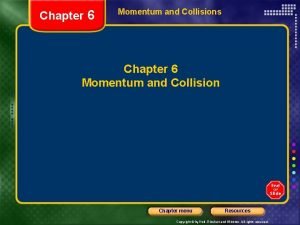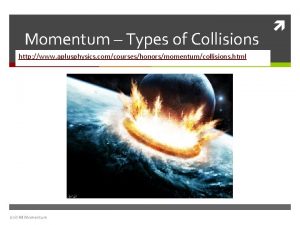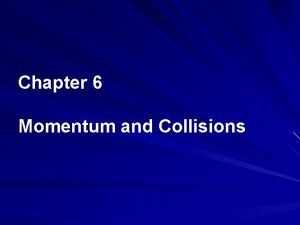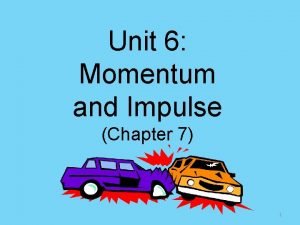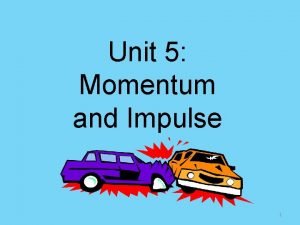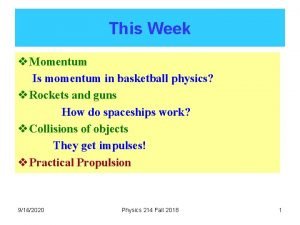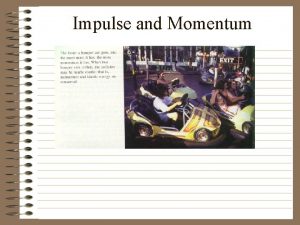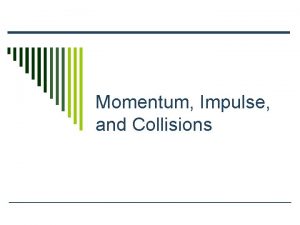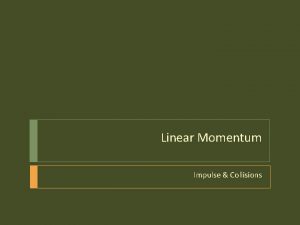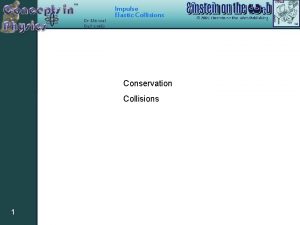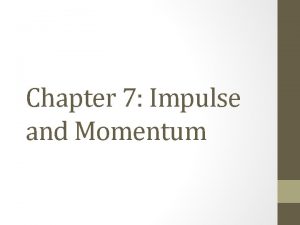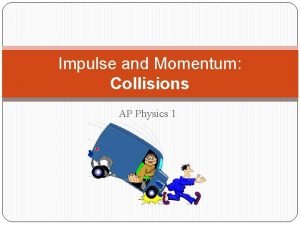MOMENTUM AND COLLISIONS MOMENTUM AND IMPULSE Chapter 6









- Slides: 9

MOMENTUM AND COLLISIONS MOMENTUM AND IMPULSE Chapter 6: Section 1

Learning Targets Compare the momentum of different moving objects Compare the momentum of the same object moving with different velocities Identify examples of change in the momentum of an object Describe changes in momentum in terms of force and time P 3. 3 b, P 3. 3 d, P 3. 4 f, P 3. 4 g

Linear Momentum The linear momentum of an object of mass (m) moving with a velocity (v) is defined as the product of the mass and the velocity. ○ Momentum is represented by the symbol p p = mv

Momentum is a vector quantity, with its direction matching that of the velocity Momentum has dimensions of mass x length/time Its SI unit is kg x m/s Momentum can be illustrated by someone riding a bike downhill. As they coast down a slope, gravity causes them to accelerate, therefore increasing their velocity ○ This increases their momentum

Changes in Momentum A change in momentum takes both force and time It takes more force to stop a fast moving object than it does to stop an object moving slowly It also takes more force to stop a more massive object ○ Change in momentum is related to force by the following equation: F = ∆p/∆t or F∆t = ∆p = mvf - mvi

A force acting for a given amount of time will change an object's momentum. (F∆t = ∆p ) An unbalanced force always accelerates an object - either speeding it up or slowing it down. This relates to Newton’s Second Law (F=ma)

Impulse-Momentum Theorem According to the Impulse-Momentum Theorem F∆t = m∆v A small force acting for a long time can produce the same change in momentum as a large force acting for a short time

Impulse F∆t is called the impulse of the force F for the time interval t Extending the time interval over which a constant force is applied allows a smaller force to cause a greater change in momentum than would result if the force were applied for a very short time

Real World Applications Air bags in cars Extending the time, reduces the force “Riding a punch” Extending the time, reduces the force Follow through with a bat Extending the time, increases velocity
 Chapter 6 momentum and collisions
Chapter 6 momentum and collisions Aplusphysics momentum-impulse answer key
Aplusphysics momentum-impulse answer key Momentum and collisions
Momentum and collisions Momentum and collisions review
Momentum and collisions review Linear momentum and collisions
Linear momentum and collisions Is momentum conserved in all collisions
Is momentum conserved in all collisions Physics 03-02 potential energy and conservative forces
Physics 03-02 potential energy and conservative forces Unit 6 momentum and impulse
Unit 6 momentum and impulse Impulse law
Impulse law How to find initial momentum
How to find initial momentum
